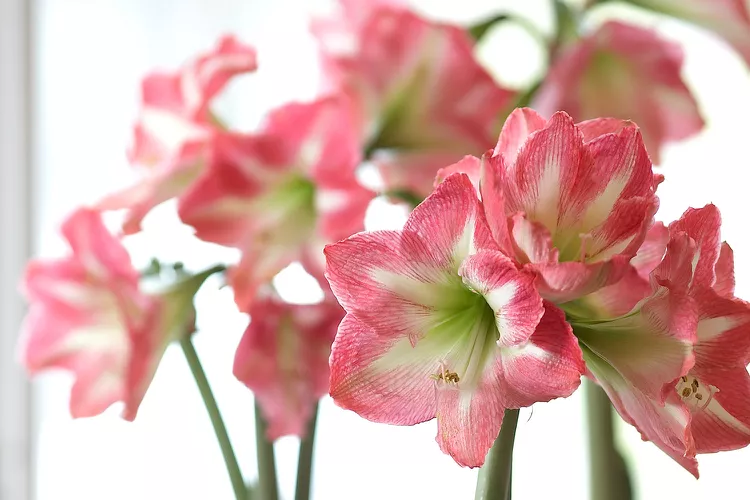Amaryllis (Hippeastrum) are popular indoor winter and holiday plants. The large amaryllis bulbs shoot up long, strappy leaves from their indoor pots and unfurl their giant flowers to give you a splash of midwinter color. Once the flower party is over, you can coax your amaryllis to blossom again the following year. With these tips, you can reinvigorate the bulbs during the summer, let them rest in the fall, and see them flower again in the winter. Amaryllis can rebloom for years if you give them the right TLC.
Caution
Keep amaryllis well away from pets or small children because all parts are toxic.
How to Pick the Right Amaryllis Bulbs
You get what you pay for when it comes to amaryllis bulbs, so buying the largest bulbs will yield the most flowers. If you see that a bulb company sells “double-nosed” or “triple-nosed” bulbs, you can look forward to two or three stalks and at least four flowers per stalk. You can grow your amaryllis bulbs shallowly potted in soil or resting in tall “forcing vases” with roots dangling into water or onto damp pebbles.
What Do You Do with Amaryllis Bulbs After They Bloom?
1. When an amaryllis flower wilts, remove it immediately so the plant doesn’t waste energy forming a seed pod. Gently snip off the bloom where it connects to the stalk, leaving the other flowers on the same stalk in place until all the flowers have faded.
2. As long as a stalk is green, it will continue photosynthesizing like the leaves, which helps feed the bulb.
3. Once a stalk withers and turns brown, cut if off about an inch above the bulb. After all the stalks have withered, move your amaryllis to a sunny location in a western or southern exposure.
4. If you were growing the amaryllis bulb in water, take it out and plant it two-thirds deep in potting soil in a container that is only 2 inches wider than the bulb. Soon, strappy leaves will grow and drape themselves over your windowsills.
What Do You Do with Waxed Amaryllis Bulbs After They Bloom?
The ultimate carefree growing method is to buy a wax-covered amaryllis bulb that doesn’t need to be watered at all and can be set in any brightly lit location indoors. This quick-fix approach will give you stalks and flowers, but the wax coating keeps the bulb from being used again. Toss it after blooming, or you can try peeling off the wax and planting the bulb in a pot as described above.
How to Get Amaryllis Bulbs to Rebloom
With plants, it's always helpful to think of their native lands. Amaryllis originated in Central and South America in locations where winter temperatures drop but don't hit freezing. You can recreate that environment and nourish the bulb with a summer vacation and a fall retreat.
1. Treat the amaryllis like a houseplant once the leaves are growing. It will thrive in bright, indirect light. Keep the soil lightly moist, and use all-purpose houseplant fertilizer once a month.
2. When warm weather has arrived for the season, with nighttime temperatures above 60℉, put your plant outdoors for its summer vacation in a part-shade spot. You can pamper your amaryllis even more by gently removing it from the pot and planting it two-thirds deep in the ground. Or keep it in its pot (and because amaryllis do well with a snug fit, this is not a hardship).
3. The amaryllis isn't a tropical plant looking for the next monsoon. Light rain, supplemented by your monthly fertilized watering, plus an extra splash during dry spells, will be enough.
4. When night temperatures go below 60℉, bring the potted bulb inside or dig up the bulb and replant it in a container indoors.
How to Induce Dormancy in Amaryllis
Your amaryllis bulb needs to go on a fall retreat to get ready to bloom again, which is what it would do in nature.
1. An amaryllis needs to be in the dark, without water, to trigger dormancy. Extra points if you have a cool (50-55℉) space to stash it. Unheated garages and basement closets are potentially suitable hiding places.
2. Don't cut off the leaves. They will gradually turn brown, continuing to feed the bulb as they dry up.
3. Set a reminder or mark your calendar to check on the amaryllis bulb after eight weeks. If it's started to push up green tips, bring it out. If not, leave it another four weeks, then snip off the dead leaves, repot the bulb two-thirds deep in fresh potting soil, water it thoroughly, and put it in full sun near a western or southern window, with an air temperature of about 65℉.
4. Don't water it until you see new growth, then water it lightly each week and fertilize it monthly. When the flowers open (in about six to eight weeks), move the plant out of direct sun to keep the blossoms going longer.
With all this TLC, your amaryllis bulb should rebloom, but this isn't necessarily a long-term relationship. Enjoy it while it lasts, then send it to the compost pile and begin again–a good excuse to try even more amaryllis colors and petal patterns.




















